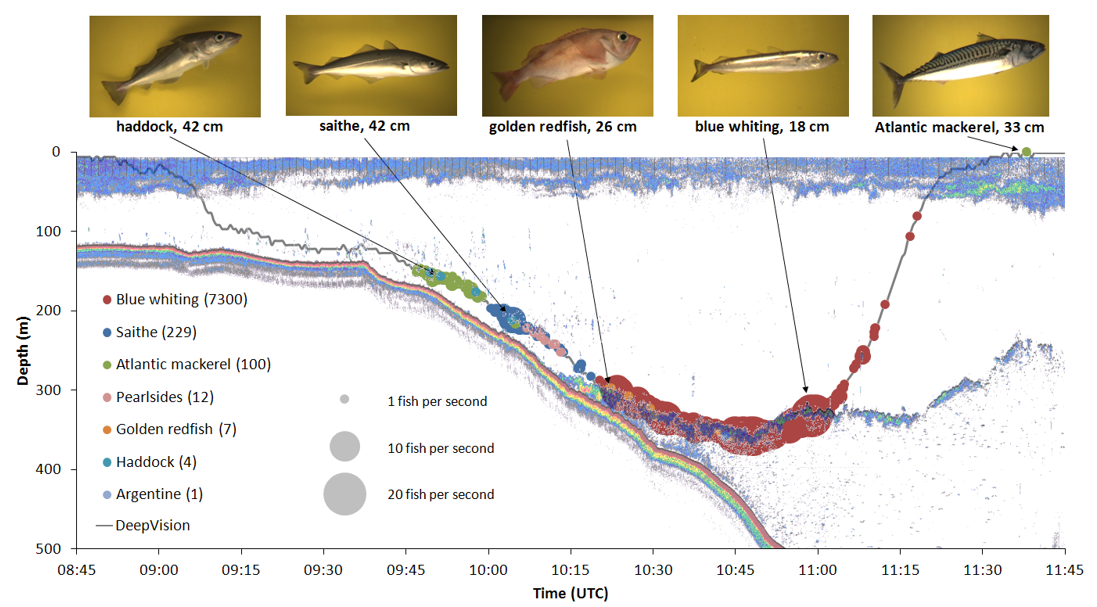DEEP VISION
For Marine Research
Efficient and sustainable fish sampling. No catch, Just data!
Key Functionality
Be informed of the species, size and location of fish entering the trawl
Combine fish echo sounder and fish imagery data from the trawl
Sample directly on your computer and catch only what is needed for biological samples
Key Benefits
Efficient eco-friendly fish sampling and analysis in the trawl
Record species, size, and location of fish from Deep Vision trawl images without catch
Analyze stocks directly on your computer
Eco-friendly fish sampling in the trawl
an invaluable tool for marine researchers
Through advanced subsea vision technology and machine learning algorithms, Deep Vision identifies and measures fish in realtime. It is possible to analyze stocks without bringing the catch onboard with a DeepVision subsea camera attached to the trawl.
Using the Deep Vision software, species are registered and lengths are automatically measured. In addition, images can be logged along with depth and time information. The figure below illustrates how GPS and echo sounder data can be used to locate fish along a haul relative to the water column.
Deep Vision in action
Feeling guilty about the fish you discard when sampling the catch?
Analyze stocks directly from your computer. No catch is needed for species, size, and location of fish in the sea.
Before
After
Below is a video showing the old version of Deep Vision underwater camera system in action taking images of cod swimming through the trawl and corresponding screenshots.
Main components
STEREO CAMERA
Takes photos of all fish entering the trawl.
ECHO SOUNDER
Combining Echo sound- and image data provides deeper knowledge of type, size, and volume
ANALYSIS SOFTWARE
Optimizes images from challenging conditions and analyzes species, size, and location of fish.
ACOUSTIC LINK
Transfers statistical data about the catch to the vessel in real-time.
CATCH OR RELEASE UNIT
Catches biological samples. The rest of the fish swim back into the sea. (To be further developed)
F.A.Q.
-
A subsea unit with stereo camera, lights and batteries attaches to the trawl with a marine zipper. The camera takes photos of all the fish that swim into the cod-end of the trawl, wether the cod-end is open or closed. Once onboard the vessel, the images are uploaded to the computer and analysed in the Deep Vision software. The images have information about time, location and depth and can be further analysed for species and size.
-
Deep Vision makes it possible to do your fish sampling and resource mapping without bringing the fish onboard the vessel. This will make your research more sustainable and save valuable marine resources in the process. Sampling will be more efficiently as it can be done on a computer instead of on deck. For biological samples you can use the Deep Vision sorting device to catch a selection of fish. Data about the fish will also be more accurate as the precise location is given. Fish that is otherwise squashed in the trawl, such as jellyfish, can also be sampled from the images.
-
No, the Deep Vision subsea unit attaches to the trawl with a marine zipper and follows the trawl net over the slip. Once onboard the vessel again, the images are uploaded to a computer via cable and analysis of the images can begin.
-
Yes, using Deep Vision images together with echosounder data can really maximize the information available to you on a trawl haul In acoustic software such as Echoview, images from Deep Vision can be uploaded and used to confirm acoustic data where this is ambiguous. You can learn more bout this integration here: https://www.youtube.com/watch?v=nm7GPf6qzsI&t=1789s&ab_channel=EchoviewSoftware&t=29m00s.
Contact us
Is there anything you would like to know more about Deep Vision for marine research?











